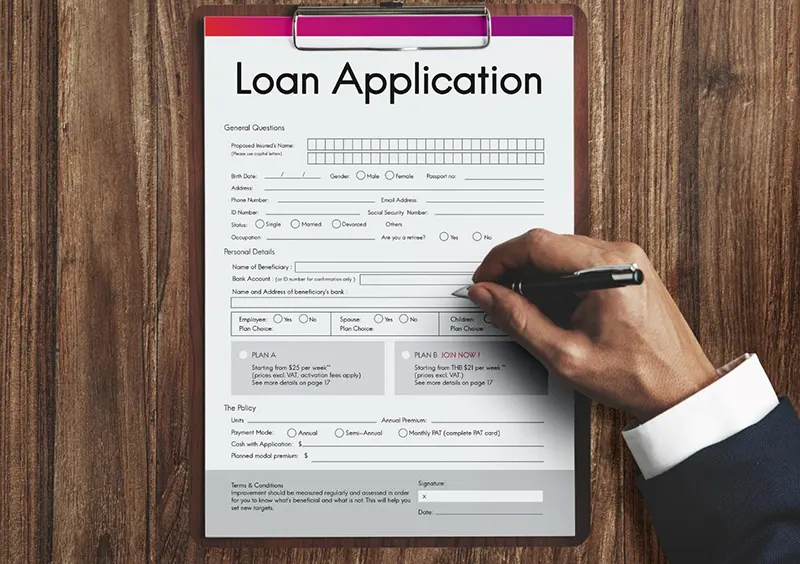By definition, a loan is always a burden, but it's value can provide much-needed relief in a stressful time. And in a world where most Americans face ever-increasing costs, borrowing with personal loans online is very common.
As of Q3 2023, 23.2 million Americans have a personal loan indicating Americans' significant usage of personal lending products.
Online loan applications can be convenient, but while lenders fight for your attention, understanding how to choose the best fit for you is critical. More lending options also means more to understand. Properly comparing fees, loan interest rates, repayment terms, lender reputation, and reliability requires more knowhow than pressing a button and getting your money.
To keep you covered on online personal loans, we'll review how to:
- Get pre-qualified and compare loan offers
- Find a trustworthy online lender for a positive and secure loan experience
- Common mistakes and tips for confidently navigating the online lending landscape
What is a Personal Loan?
In its simplest form, a personal loan is a financial tool that allows individuals to borrow a specific amount of money from a lending institution, which they are then obligated to pay back with interest over a predetermined period.
These loans are primarily categorized into three types: secured loans, which require collateral and generally have lower interest rates; unsecured loans, which don't require collateral but often come with higher interest rates and depend on the borrower's creditworthiness; and peer-to-peer loans, which connect borrowers directly with investors via online platforms, offering flexible terms.
The purposes of personal loans are varied, catering to different financial needs. They are most commonly used for debt consolidation, allowing borrowers to merge multiple debts into a single loan with potentially lower interest rates. Other typical uses include home renovations like roof financing, medical expenses, and large purchases like appliances or weddings.
Pros and Cons
Pros
- Convenience: Apply from anywhere, anytime.
- Speed: Quick processing and fast funding.
- Easier Access: More lenient approval criteria for those with less-than-perfect credit.
- Comparison and Choice: Easy to compare lenders, rates, and terms online.
- Paperless Transactions: Environmentally friendly and streamlined process.
Cons
- Higher Interest Rates: Especially for unsecured loans and those with lower credit scores.
- Risk of Scams: Need to be vigilant against fake loan companies.
- Overborrowing Risk: Ease of obtaining loans can lead to borrowing more than necessary or affordable.
- Obscured Fees and Terms: Potential for overlooked fees or complex terms in loan agreements.
Eligibility Criteria
When considering an online personal loan, understanding the eligibility criteria is crucial. These requirements can vary between lenders but typically include:
- Credit Score
- Income Level
- Debt-to-Income Ratio
- Employment History
- Age and Residency
- Bank Account
Interest Rates
Understanding interest rates, particularly APR (Annual Percentage Rate), is vital when comparing loan offers.
- APR vs. Simple Interest Rate: The APR is a more comprehensive measure of the cost of borrowing. In contrast, a simple interest rate reflects only the interest charged on the principal amount.
- Importance of APR: APR provides a more accurate picture of the total cost of the loan. A lower APR generally means a lower cost to the borrower.
- Comparing APRs: When shopping for personal loans, compare APRs from different lenders to find the best deal. Remember that the lowest APR may not always be the best option if there are significant fees or the loan terms are unsuitable for your needs.
- Fixed vs. Variable APR: Fixed APRs remain the same throughout the loan term, offering predictability in repayments. Variable APRs can change based on market conditions, which might lead to fluctuating payment amounts.
Repayment Terms
Repayment terms are critical to any loan agreement, as they dictate how and when the loan will be paid back. Understanding different repayment schedules and their implications is essential for borrowers.
- Repayment Schedules: Common schedules include monthly and bi-weekly payments. Monthly payments are standard and involve a fixed amount due each month. Bi-weekly payments, made every two weeks, can result in faster loan repayment and less interest paid overtime.
- Longer vs. Shorter Repayment Terms:
- Longer Terms: These can make monthly payments more manageable as the loan amount is spread over a more extended period. However, this usually results in higher total interest paid over the life of the loan.
- Shorter Terms: While these can lead to higher monthly payments, the total interest paid is generally lower, making the loan less costly in the long run.
Fees and Penalties
Personal loans come with various fees and penalties that can significantly impact the cost of borrowing. Origination fees are one-time charges for loan processing, often deducted from the loan amount before disbursement. Prepayment penalties can offset interest savings from early repayment, so understanding these is crucial.
Late fees are charged when a borrower misses a payment deadline, potentially affecting their credit score. It's essential to read the loan agreement thoroughly to understand all fees and penalties, as hidden costs can significantly increase the loan's overall expense.
How to Evaluate Online Lenders

Online lending platforms have revolutionized the loan landscape, offering benefits like greater convenience, faster processing times, and often more competitive rates than traditional banks. However, evaluating these lenders requires careful consideration.
- Reputation
- Customer Reviews
- Transparency
- Regulatory Compliance
Different Types of Online Lenders
The online lending market comprises various lenders, each with unique features and benefits.
- Peer-to-Peer (P2P) Platforms:
- Pros: Often offer more competitive rates and flexible terms. They can be more accessible for those with lower credit scores.
- Cons: Individual investors rather than larger financial institutions.
- Traditional Banks with Online Services:
- Pros: Combine traditional banks' reliability and comprehensive services with the convenience of online access.
- Cons: May have more stringent eligibility requirements and slower processing than other online options.
- Online-Only Banks:
- Pros: Typically offer lower fees and better rates due to lower overhead costs. They are often more innovative in their product offerings. For smaller dollar loans, some lenders have even shifted to a mobile apps approach.
- Cons: Lack of physical branches can be a drawback for those who prefer in-person services.
Safety and Security
When engaging in online financial transactions, data security is paramount. It is crucial to use a secure website, read the lender's privacy policy, ensure data encryption is used, understand data sharing, and verify if the lender complies with data protection regulations and industry standards.
Additionally, avoid using public Wi-Fi networks when applying for loans, as they can be less secure and more susceptible to breaches. Following these guidelines, you can protect your personal and financial information while making online transactions.
How to Get a Loan Online
Successfully securing an online loan involves a series of steps that require careful consideration and preparation. Here's a simple checklist to navigate this process:
- Check Your Credit Score: Your credit score significantly impacts your approval odds, loan terms and interest rates, so it's crucial to know its importance. Take necessary steps to improve it, such as correcting errors, making timely payments and pay down debt as possible.
- Gather Necessary Documentation: Collect documents like proof of income (pay stubs, tax returns) and identification (driver’s license, passport).
- Understand the Pre-Qualification Process: Pre-qualification is when a borrower provides basic financial information to a lender, estimating the loan terms they might receive without affecting their credit score.
- Soft vs. Hard Credit Inquiries: Soft inquiries occur during pre-qualification and don't affect credit score, while hard inquiries occur after a lender reviews your credit report, potentially impacting your credit score.
- Impact on Credit Scores: Loan applications can impact your credit score, as each application may lead to a hard inquiry, potentially temporarily lowering your credit score.
- Applying for an Online Personal Loan: Choose a lender based on research, reputation and your pre-qualification, complete the online application form with all required documents, and carefully review the loan offer to ensure understanding of all terms and conditions.
- Read and Compare Loan Offers: Pay attention to total cost, the Annual Percentage Rate (APR), which should interest rate and additional fees, and compare loan terms, including loan length and additional fees or penalties.
Common Pitfalls to Avoid
When navigating the world of online personal loans, it's crucial to be aware of common pitfalls to ensure a safe and beneficial borrowing experience.
- Beware of Predatory Lenders
- Recognize Online Loan Scams
- Protect Personal and Financial Information
How to Manage Online Personal Loans Responsibly
To maintain financial health and achieve specific financial goals, it is crucial to manage online personal loans responsibly. Strategies for loan repayment include setting up automatic payments, budgeting effectively, and handling repayment difficulties.
Contact your lender for restructuring options or consult a financial advisor if you face repayment difficulties. Only borrow what you need and use personal loans wisely for purposeful financial goals like debt consolidation or home improvement, and regularly review your loan statements to stay informed about your balance.
Are Online Loans Right for You?
Deciding whether an online loan is the right choice depends heavily on individual circumstances and financial health. It's essential to conduct a thorough self-assessment before making this decision.
- Assessing Financial Health:
- Income Stability
- Existing Debts
- Credit Score
- Savings
- Purpose of the Loan:
- Ensure that the purpose of the loan aligns with the terms and types of loans available. For instance, a short-term financial gap might be better served by a different type of credit (like a 0% interest balance transfer card) than a long-term investment like home renovation.
- Online Loan vs. Traditional Bank Loan:
- Scenarios for Online Loans: If you need quick funding, appreciate the convenience of online applications, or are looking to compare many rates, online loans might be more suitable.
- Scenarios for Traditional Bank Loans: If you prefer in-person interactions, and have maintained a strong relationship with your branch, traditional banks might offer more advantages.
Summary
While, it's key to know your needs and ability to repay, the preparation doesn't stop there.
It's important to also remember:
- Research and compare all your loan options, evaluating lenders based on their reputation, reviews are key to getting the best loan for you.
- Understanding possible online risks such as predatory lenders and online scams







